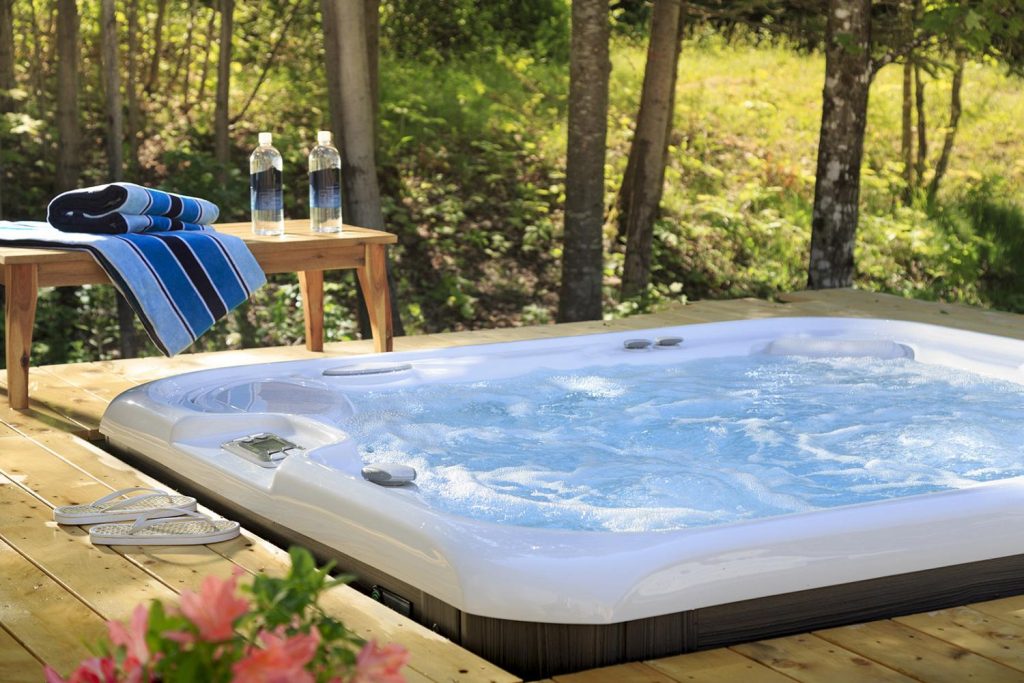If you’re looking to become a hot tub owner, you’ve probably heard the buzz about saltwater systems. Claims like “chemical-free,” “easy maintenance,” and “better for your skin” are everywhere. But do these claims hold water, or are they just marketing hype? While saltwater hot tubs have surged in popularity recently, it’s important to take a closer look at whether they’re really a better choice than traditional chlorine-based systems.
While saltwater hot tubs may seem appealing at first, there are several key factors to reconsider before making your purchase.
Saltwater hot tubs: the quick answer
A saltwater hot tub is a spa that uses a salt chlorine generator to turn dissolved salt into sanitizer through electrolysis—so it keeps water clean by making chlorine, rather than you adding as much chlorine by hand.
Are saltwater hot tubs chlorine-free? No. They’re often marketed as “chemical-free,” but a salt system still produces chlorine (just generated from salt inside the system). If you’re deciding between saltwater and a traditional chlorine setup, here are the real tradeoffs sellers don’t always mention—cost, maintenance, and long-term wear on components.
What Is a Saltwater Hot Tub? A Brief History
Saltwater hot tubs evolved alongside saltwater systems for swimming pools in New Zealand in the 1980s. The technology uses electrolysis to turn dissolved salt (sodium chloride) into chlorine, effectively sanitizing the water without the need for traditional chlorine chemicals. Though it worked well for swimming pools, it took longer for saltwater hot tubs to gain traction. By the 1990s, people began appreciating the benefits of saltwater—specifically how it created water that felt more natural and was less irritating to the skin and eyes.
However, despite being called “saltwater,” these hot tubs still produce chlorine via the electrolysis process. The key difference is that the chlorine generated is typically gentler on your skin and eyes than traditional chlorine treatments. This made saltwater systems more attractive to many, offering a different kind of hot tub experience. Still, it’s just one option—what works best for you depends on what you’re looking for in your hot tub experience.
Saltwater Hot Tub Myths Debunked
While saltwater hot tubs are often praised for being “chemical-free” and low-maintenance, it’s important to separate fact from fiction. Let’s break down the most common myths surrounding saltwater systems and hot tub water treatment.
Myth #1: Saltwater Hot Tubs Are Chlorine-Free
It’s important to remember that saltwater hot tubs still produce chlorine. When salt is dissolved in hot water and exposed to the electrolysis process, the result is chlorine. The difference lies in how the chlorine is produced—saltwater systems use a salt chlorine generator, while traditional hot tubs rely on chlorine tablets. Both types of hot tubs sanitize water with chlorine, but the key distinction is how it’s generated. Whether it’s naturally produced or manually added, chlorine is necessary to keep the water clean and free from bacteria.
Myth #2: Saltwater Hot Tubs Are Cheaper
Saltwater systems often seem like a bargain because a 40lb bag of salt costs around $15-25, while a small container of chlorine granules for traditional hot tubs can cost $30-50. However, the upfront installation cost of a saltwater system can be as high as $4,500-10,000, depending on the system’s quality. You might never recoup this initial investment, and it could take years to see any real savings. Additionally, saltwater hot tubs require regular replacement of the salt cell (chlorinator), which can be very costly every few years.
In contrast, traditional hot tubs typically don’t require parts like a salt cell, making them a more cost-effective choice in the long run.
Myth #3: Saltwater Hot Tub Maintenance is Simple
Many saltwater hot tub sellers claim their systems are low-maintenance and self-regulating, meaning owners won’t be required to have regular pH tests and chemical level adjustments. However, this isn’t entirely accurate. Due to the chemical reaction between salt and the electrolysis process, saltwater hot tubs often accumulate higher levels of calcium, which can lead to scaling and residue buildup. You’ll need to manage calcium levels by adding a calcium remover or deal with occasional buildup on the edges of your tub.
Other maintenance tasks, such as cleaning filters and regularly testing salt levels, are still necessary. Although saltwater systems reduce the need for constant chlorine adjustments, they come with their own set of maintenance requirements, including monitoring water balance and replacing parts like the salt cell.
Myth #4: Saltwater is Better for Your Hot Tub
Saltwater may seem like a better option for your hot tub because it’s gentler on the skin and eyes. However, saltwater has one major drawback: corrosion. Just like the ocean water, salt can be harsh on metals and components in your hot tub. The electrolysis process can break down materials like jets, piping, and heating elements, leading to costly repairs. Metal parts exposed to the saltwater can also rust over time. Regular cleaning of your hot tub’s metal components is necessary to prevent damage and extend the life of your hot tub.
Additionally, saltwater can be harmful to nearby plants and bleach deck boards, so you’ll need to rinse the area after use.
An Alternative: Ozone vs. Saltwater Hot Tub
If you’re torn between saltwater and traditional hot tubs, there’s another option to consider: an ozone generator. These systems naturally purify the water by generating ozone (O3), which helps kill bacteria and break down contaminants. Ozone generators are cost-effective, require fewer water changes, and provide a natural water treatment method. If you’re looking for a more chemical-free experience without the drawbacks of saltwater, this could be the ideal choice.
Both Saltwater and Traditional Hot Tubs Use Chemicals
It’s important to note that whether you’re using a saltwater hot tub or a traditional chlorine system, both require chemicals to maintain water quality. In a saltwater system, the electrolysis process produces chlorine, and this chlorine works to sanitize the water and kill bacteria. Traditional chlorine-based systems, on the other hand, rely on chlorine tablets to achieve the same goal. So, regardless of which system you choose, you’ll still be using chlorine to maintain a clean and safe hot tub experience.
Saltwater vs Chlorine Hot Tub: What’s the Difference?
Both systems sanitize with chlorine—the main difference is how that chlorine gets into your water. Salt systems generate chlorine from salt via electrolysis, while traditional systems rely on adding chlorine products manually.
| Factor | Salt Water Hot Tub | Chlorine Hot Tub |
| Does it use chlorine? | Yes (generated from salt via electrolysis) | Yes (added as a product) |
| Day-to-day upkeep | Often less frequent dosing, but still requires testing & balancing | Regular testing & dosing |
| Water feel/odor | Many owners report “softer” feel and less odor (varies) | Can be stronger odor if chemistry drifts |
| Equipment wear risk | Higher corrosion/scale risk if chemistry isn’t kept in range | Lower salt-driven corrosion risk |
| Ongoing parts | Salt cell/cartridge replacements | No salt cell/cartridge |
| Best for… | People who want more automated chlorination and don’t mind higher system cost | People who want lower upfront cost and simpler hardware |
Recap: Saltwater Hot Tub Pros and Cons
Pros:
- Lower Chemical Usage: Saltwater systems generate chlorine naturally, reducing the need to manually add chlorine.
- Less Odor: Saltwater hot tubs tend to have a less intense chlorine smell compared to traditional chlorine-based systems.
- Gentler on Skin and Eyes: Unlike traditional chlorine, saltwater is often gentler, making it better for sensitive skin.
Cons:
- Higher Initial Cost: Saltwater systems can be significantly more expensive to install than traditional chlorine-based systems.
- Corrosion Risk: The salt in the water can corrode metal parts over time, increasing the need for regular maintenance.
- More Maintenance: While they reduce the need for manual chemical adjustments, saltwater hot tubs require a fair amount of maintenance to keep salt levels balanced and prevent calcium buildup.
Who should choose what?
Saltwater makes sense if you:
- Want a more automated sanitizer system (less manual dosing)
- Don’t mind replacing a cell/cartridge as part of normal ownership
- Are committed to consistent water-balance testing (salt systems aren’t “set it and forget it”)
Traditional chlorine makes sense if you:
- Want the lowest upfront equipment cost
- Prefer simpler hardware (fewer specialized parts to replace)
- Don’t mind regular testing and manual adjustments

Looking for an Alternative to a Saltwater Hot Tub?
At Cal Spas of Minnesota, we don’t say whatever it takes to make a sale—we say it like it is. If we don’t truly believe our hot tub or swim spa is the best option for your family, we won’t sell it to you. It’s that simple.
For over 35 years, we’ve been offering Minnesotans a complete lineup of home resort and wellness products designed to turn their backyards and patios into their own private retreats. So whether you’re in the market for a pre-owned spa or want to check out the latest new hot tubs, swim spas, or gazebos we’ve got something in store for you. Contact us today for a free spa consultation.
Saltwater Hot Tub FAQs
Do saltwater hot tubs use chlorine?
Yes. A saltwater hot tub uses electrolysis to convert dissolved salt into chlorine sanitizer. The system changes how chlorine is delivered, not whether chlorine is used.
Can you convert a hot tub to saltwater?
Sometimes. Some hot tubs can be retrofitted with a compatible salt system, but it depends on the manufacturer’s guidance, the circulation/plumbing setup, and whether the warranty allows it. Conversion kits exist, and costs vary widely by model and parts required.
Are saltwater hot tubs better than chlorine?
It depends on what “better” means for you. Saltwater can feel gentler and automate chlorine generation, but it may add cost and introduce parts (cells/cartridges) that need replacement. Traditional chlorine often costs less upfront and keeps the hardware simpler.
What are the biggest saltwater hot tub pros and cons?
Pros: automated chlorination, potentially less odor, often a “softer” feel.
Cons: higher upfront system cost, replacement parts (cell/cartridge), and greater risk of corrosion/scale if water balance slips.
How do you maintain a saltwater hot tub?
You still test and balance water regularly. Key tasks include checking sanitizer output, monitoring pH/alkalinity/calcium, cleaning filters, confirming salt level, and replacing the cell/cartridge when it stops producing sanitizer effectively.
Are saltwater hot tubs banned in Canada?
Saltwater systems themselves aren’t “banned,” but Canada has issued guidance about not combining certain bromine products (like sodium bromide) with electrolysis/ozone/UV systems. If you’re shopping, ask exactly which chemicals are being used with the system.


